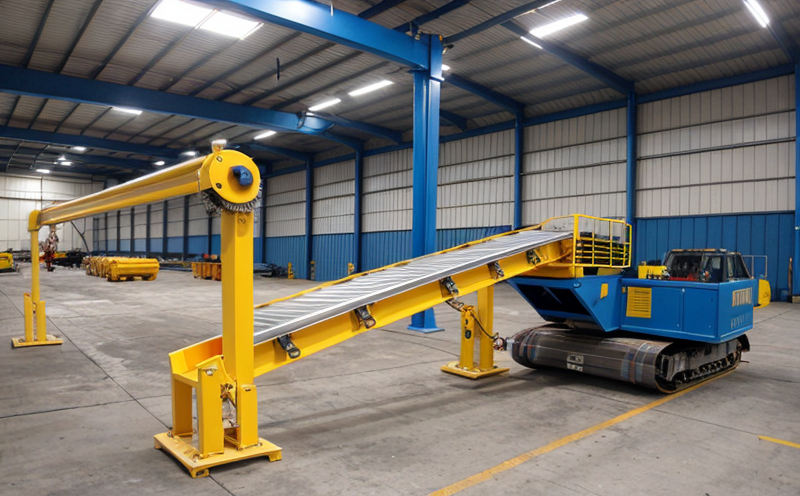MSHA Flame Resistance Testing of Conveyor Belts for Underground Mines
The Mine Safety and Health Administration (MSHA) flame resistance testing is a critical requirement for conveyor belts used in underground mines. This testing ensures that the materials employed are inherently resistant to igniting, spreading flames, or producing excessive amounts of smoke, thereby safeguarding miners from potential life-threatening hazards.
Understanding the scope of this testing requires an overview of its importance and the context within which it is performed. Conveyor belts in underground mines handle large volumes of material, making them a significant fire hazard if not properly designed with flame-resistant properties. The MSHA standards are stringent to ensure that any conveyor belt used in these environments meets the highest safety benchmarks.
The testing process involves subjecting the conveyor belt to specific conditions intended to mimic real-world scenarios. Specimens are prepared by cutting sections of the belt according to precise dimensions and specifications laid out by relevant international standards (ISO, ASTM). These standards ensure that all tested samples undergo identical preparation methods, providing a consistent basis for comparison.
The testing apparatus used includes a specially designed furnace capable of applying controlled heat sources. The specimens are exposed to these heat sources under specified conditions until they either pass or fail based on predefined criteria. Failure means the material ignites, sustains burning longer than allowed, or produces excessive smoke. Passing indicates that the belt meets MSHA flame resistance requirements.
The results from this testing play a crucial role in compliance with regulatory requirements and can significantly influence product design decisions. Compliance officers need to be aware of these tests as they ensure adherence to legal standards set by MSHA. Quality managers rely on test outcomes to improve production processes, while R&D engineers use them to innovate safer materials.
Competitors who invest in rigorous flame resistance testing demonstrate their commitment to safety and regulatory compliance, which can enhance their reputation among clients and stakeholders. This investment also provides a competitive edge by ensuring that products meet or exceed the latest safety standards, thereby reducing risk and liability associated with non-compliant materials.
Applied Standards
The MSHA flame resistance testing of conveyor belts is governed primarily by 30 CFR Part 75, which outlines the specific requirements for conveyor belts in underground mines. These standards are based on internationally recognized benchmarks such as ISO, ASTM, and EN.
- ISO 17892-4: This standard provides guidelines for the determination of flammability of plastics used in electrical and electronic equipment.
- ASTM D635: This method covers the procedure for determining the burning characteristics of fabric materials by means of a cone calorimeter.
The testing process adheres strictly to these standards, ensuring that all conveyor belts meet stringent flame resistance criteria. Compliance with such rigorous standards not only meets regulatory requirements but also enhances product safety and reliability.
Quality and Reliability Assurance
- Consistency in Testing: The laboratory ensures consistent testing by maintaining calibrated equipment and trained personnel who follow strict protocols. This consistency is crucial for accurate results that can be relied upon for decision-making.
- Data Integrity: All test data are meticulously recorded and stored, allowing for transparent reporting and traceability of each sample tested. This integrity supports quality assurance efforts by providing reliable evidence for any regulatory inquiries or internal audits.
The laboratory employs advanced instrumentation to conduct flame resistance testing, ensuring precise results that meet the stringent requirements set forth by MSHA. The use of state-of-the-art equipment minimizes human error and enhances test accuracy.
Quality assurance in this context also involves continuous improvement efforts aimed at refining testing methods and enhancing overall reliability. By staying abreast of industry trends and technological advancements, the laboratory ensures that its services remain cutting-edge and relevant to current regulatory expectations.
Competitive Advantage and Market Impact
Investment in MSHA flame resistance testing can provide significant competitive advantages for mining companies. By ensuring compliance with stringent safety standards, these companies demonstrate their commitment to worker safety, which enhances reputation and trust among clients and stakeholders.
- Innovation: The results from this testing guide product development efforts towards safer materials, fostering innovation within the industry.
- Regulatory Compliance: Companies that meet MSHA standards are less likely to face penalties or fines associated with non-compliance, reducing legal risks and operational costs.
The market impact of adhering to these standards is substantial. It not only ensures worker safety but also promotes a safer working environment, which can lead to higher productivity levels within the mining sector. This commitment to safety can attract more investment and talent into the industry, further strengthening its position in the global market.





